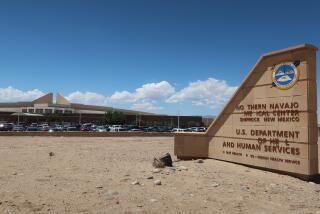Access to healthcare for the poor varies widely among states
- Share via
WASHINGTON — Access to affordable, quality healthcare for poor Americans varies dramatically among the states, according to a new study that found a wide disparity in measures of health between states with the best healthcare systems and those with the worst.
In the highest-performing states, low-income, less educated residents are more likely to be covered by health insurance, to have a regular source of medical care and to get recommended preventive care, such as cancer screenings.
These Americans were also less likely to die prematurely or end up in the hospital for conditions such as diabetes and asthma, the report from the nonprofit Commonwealth Fund found.
“There are often two Americas when it comes to healthcare, divided by geography and income,” the study’s authors concluded.
The disparities highlighted by the report — titled “Healthcare in the Two Americas” — were supposed to shrink under President Obama’s healthcare law, which was designed to guarantee healthcare access for all Americans no matter where they live.
Starting next year, the Affordable Care Act will require insurers to provide coverage to consumers with preexisting medical conditions and offer a basic set of benefits.
But many states with Republican leaders are fighting the law, and nearly half have declined federal aid to expand insurance coverage to their poorest residents through the government Medicaid program. GOP officials in these states say the law is too costly and imposes too many federal regulations.
Cathy Schoen, the study’s lead author and the fund’s senior vice president, said the results suggest the new health law could make a difference if states ranked at the bottom were to take advantage of new tools and resources in the law to bring their systems up to the standards of the highest-ranking states.
“We ought to be able to close the geographic divide,” she said. “There is potential for a real leap forward.”
The report, a score card based on 30 indicators, does not analyze the potential effect of the 2010 healthcare law, but it shows that states resisting the law already have among the weakest health safety nets.
In Texas, for example, 55% of working-age adults who make less than twice the federal poverty level lack health insurance, the highest rate in the nation. Texas Gov. Rick Perry is a leading critic of the Affordable Care Act.
The uninsured rate for low-income adults also tops 40% in Alaska, Florida, Georgia, Louisiana, Mississippi, North Carolina, Oklahoma, South Carolina, Virginia and Wyoming. These states have refused to expand their Medicaid programs to cover more poor residents under the healthcare law.
By contrast, seven of the eight states where the uninsured rate for low-income adults is 30% or lower are implementing the new health law with expanded Medicaid programs.
These states include Connecticut, Delaware, Hawaii, Maine, Massachusetts, Minnesota and Vermont. Of them, only Maine, which has a Republican governor, is not opening its Medicaid program to all of its poorest citizens.
In Massachusetts, which already guarantees its residents health coverage under a 2006 state reform law, just 12% of low-income adults lack health coverage, the report notes.
The wide variations in insurance coverage in many cases are mirrored by disparities in access to care, quality of care and even health outcomes.
Low-income adults over 50 years old were nearly twice as likely to get recommended preventive care in Massachusetts as they were in Idaho, for example.
And poor seniors on both Medicare and Medicaid in Alabama, Louisiana and Mississippi were 2 1/2 times as likely to be prescribed a dangerous medication as their counterparts in Massachusetts, the top performing state.
Researchers at the Commonwealth Fund found much narrower variations among high-income populations in different states.
More to Read
Inside the business of entertainment
The Wide Shot brings you news, analysis and insights on everything from streaming wars to production — and what it all means for the future.
You may occasionally receive promotional content from the Los Angeles Times.











